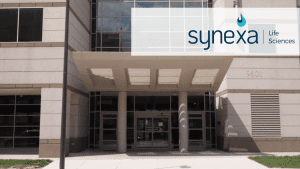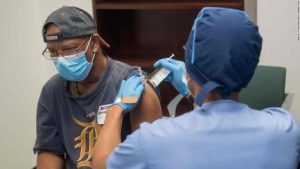
With Pandemic in Rearview Mirror, BriaCell Charges Ahead with Cancer Immunotherapy
By Mark Terry
April 25, 2023
Many biopharma companies had to place their clinical trials on hold during the first part of the COVID-19 pandemic or shift to some sort of virtual or hybrid model. Not many companies, however, were listed on the Nasdaq with plans to initiate clinical trials within days of the global economy shutting down. BriaCell did just that and is now charging ahead with pivotal clinical trials in the immuno-oncology space.
BriaCell, with headquarters in Philadelphia and Vancouver, British Columbia, recently presented data supporting its lead product candidate, Bria-IMT, at the American Association for Cancer Research (AACR) Annual Meeting. Company president and CEO William Williams, M.D., took time to talk with BioBuzz about the roots of the company, the science behind its targeted immunotherapies for cancer, and the plans moving forward.

The company came out of the research of company founder Charles Wiseman, M.D. Wiseman was conducting immuno-oncology work at MD Anderson Cancer Center, then at St. Vincent Medical Center.
“He would take biopsies from patients. He developed cell lines and those cells lines he would then irradiate and use them to immunize other patients with the same kind of cancer,” Williams said.
It was an early effort at so-called cancer vaccines. Williams notes that cancer vaccines had a bad name for a while “because they didn’t do very well, but seem to be making a comeback, especially with the recent Moderna success using neo-epitope vaccines.”
Wiseman had early success in treating cancer patients with his allogeneic approach, meaning that cells from other patients can be used to treat patients in an off-the-shelf fashion. The earliest success in immuno-oncology, typically in CAR-T, were autologous, meaning the cells were collected from the cancer patient, modified, then re-infused back into the patient, where they were now programmed to attack the cancer.
“What we have that appears to be unique are cells that can function as both cancer cells and immune cells at the same time,” Williams said. “Their function as cancer cells is to stimulate an immune response against cancer specifically. And their function as immune cells is to stimulate an immune response against cancer specifically. So they are both working together that way.”
The company’s lead product is Bria-IMT.
“Part of the history of cancer vaccines is that they were all being developed before there were checkpoint inhibitors. And the problem is that even if you stimulate a good immune response against the cancer, the cancer can put PDL-1 on its surface, or some of these other suppressive molecules, and shut down the immune response,” Williams said.
Examples of checkpoint inhibitors include Merck’s Keytruda (pembrolizumab), Bristol Myers Squibb’s Opdivo (nivolumab) and Yervoy (ipilimumab), and Genentech’s Tecentriq (atezolizumab).
Williams went on to say, “So our approach is combined with a checkpoint inhibitor, which basically takes the foot off the brakes of the immune system while we’re putting the foot on the gas. But unlike checkpoint inhibitors, which take the foot off the brakes of the entire immune system and therefore sometimes can cause autoimmune disease, our approach is very targeted, just generating an immune response against cancer cells.”
This has to do with the nature of Bria-IMT and the earlier cell lines developed by Wiseman. Williams, whose background is in immunology and rheumatology, notes that HLA molecules (human leukocyte antigens) that are found on most cells in the body are broken down into two classes, Class 1 and Class 2. There are essentially three different “flavors” of Class 1 and four different flavors of Class 2, Williams said, “and it’s kind of like your genetic barcode. So your immune system can recognize what’s your cell and not an invading cell of some kind. But Class 2 molecules typically are just on immune cells. And they’re the ones that stimulate helper T-cells. Whereas the Class 1 molecules, if there’s an antigen bound to them, they’ll stimulate killer T-cells.”
Most cancer vaccine research has been focused on killer T-cells. “But we think that the helper T-cell part is important because with one of Wiseman’s earliest patients, the first example matched at Class 2 HLA types. And when we did more research, found that that the SV-BR-1 GM cells express Class 2 HLA types.” In short, this allows the therapy to bypass another type of cell, dendritic cells, but they don’t stimulate naïve T-cells — they can’t start an immune response, but they can boost an immune response. This research was published in 2018.
Before that research, however, Wiseman’s funding dried up until, Williams said, “things kind of went into the deep freeze for a number of years until he was able to engineer a reverse takeover into a Canadian shell company and get it recapitalized. Then things started to get out of the deep freeze, he got a GMP manufacturer at the UC Davis GMP facility, whom we continue to use, and also other GMP manufacturers.”
Williams came on board in 2016 and they were able to get back into the clinic in 2017. They treated more patients and demonstrated there were “other remarkable responders, and again, they had this HLA matching characteristic,” Williams said. “Some of them match just at Class 2, some match at Class 2 and Class 1, some at Class 1.”
He described one patient who was heavily pretreated and had 20 lung metastases as well as cancer in her liver. With the treatment, she “responded remarkably with all 20 lung metastases either disappearing or shrinking down to tiny scars. And she showed improvement elsewhere. And she also was a double HLA match, one Class 1 and one Class 2. So this gave us a lot of confidence going forward,” Williams said.
But they noticed that these patients also expressed PDL-1. Over time, the therapy showed promise, but they also went “back and genetically engineered the cell so they expressed 15 different HLA types in four different cell lines, so each cell line can express two Class 1 molecules and two Class 2 molecules,” Williams said.
“And with these 15 HLA types and four cell lines, we’re able to single match over 99% of the population and double match about 90%. And that’s something we’re hoping to introduce into the clinic this summer.”
They have also engineered the cells to express additional pro-stimulatory molecules and cytokines.
“We have data that indicates we can now stimulate naïve T-cells and basically start an immune response as well as boost an immune response,” Williams said.
This refers to their Bria-OTS product, with the OTS standing for off-the-shelf. The company hopes to get that product into the clinic within the next year or so. “We’re also going to be using that approach in prostate cancer, lung cancer, and melanoma, for starters,” Williams said.
Much of this occurred after the company moved from the Toronto Venture Exchange, which Williams indicated was not particularly biotech-friendly, to the Nasdaq. The company appeared on the Nasdaq in January 2020, just as the COVID-19 pandemic was ramping up. They followed with an investor roadshow in February and March of 2020.
“Obviously the timing couldn’t have been worse,” Williams said. “Our plan was to close our deal on March 17 of that year. That was the third lowest day in the market, and everything was put on hold.”
Meanwhile, the company had accumulated $4.5 million in debt.
“And 2020 was torture because we couldn’t pay anybody. My staff left, everybody but our VP of Corporate Development. Nobody was getting paid. We were just getting loans to keep the company alive. But then, finally, in February of 2021, the market turned around,” Williams said.
The company conducted a capital raise and raked in almost $29 million. Then in June of that year, after they reported some good data, BriaCell raised another $25 million. The company also raised about $12 to $15 million by exercising warrants.
At the company’s last financial statement, it had about $33.5 million in the bank, which should be enough runway to get them into a Phase III pivotal study. “We’re not really under the gun to get financing at this point,” Williams said. “The goal is to get that corporate partner lined up who will help us with the pivotal study.”
By this, Williams refers to large biopharma companies, typically ones with checkpoint inhibitors, who want to partner with them on Bria-IMT and potentially Bria-OTS.
In addition to all the clinical movement, on March 30, the company announced plans to spin out some of its preclinical assets into a new company. These assets are T-cell engagers and PKCδ inhibitors.
At the AACR Annual Meeting, BriaCell presented four posters that bolstered both programs. The safety profile looks good and the earlier trial data suggests a 12-month survival benefit, an improvement over most other regimens that suggest six to 10 months. The company went to the FDA late in 2022 and was granted Fast Track designation. Then in January, the FDA held an end-of-Phase II meeting where BriaCell discussed using overall survival as the endpoint for the pivotal trial.
Williams said, “We think we have a very good shot at proving that we have a benefit in overall survival in our next study. We’re in the process right now of fleshing out and finalizing the full protocol to send to the FDA and get feedback from them regarding the more detailed protocol. And at the same time, we’re in conversation with basically every pharma company that has a PD1 or PD-L1 inhibitor to see if they want to partner with us in the pivotal study.”
- About the Author
- Latest Posts
Mark Terry is a freelance writer, editor, novelist and ghostwriter. He holds a degree in microbiology & public health and spent 18 years in infectious disease research and clinical and research genetics prior to his transition to a writing career. His areas of expertise include biotechnology, pharma, clinical diagnostics, and medical practice management. He has written literally thousands of articles, as well as market research reports, white papers, more than 20 books, and many other written materials. He currently lives in Michigan with his family.










